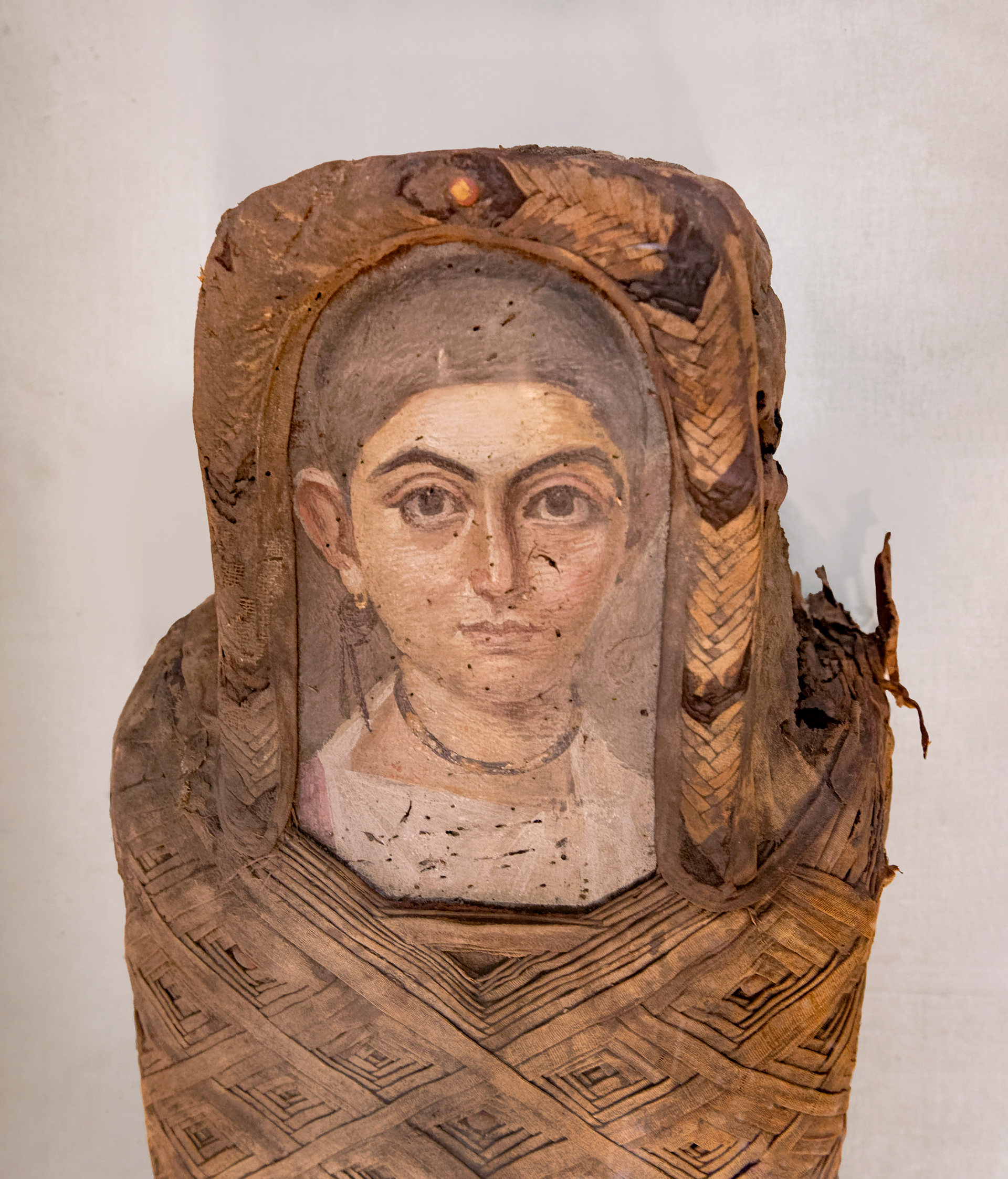There are three stories to tell
There are three stories to tell about Fayum Portraits: the ancient, the historic and the modern. All are compelling, and each is integral to understanding these phenomenal masterworks.

The Ancient
Two thousand years ago, wealthy cosmopolitan Egyptians, Greek speaking but steeped in Egyptian myth and religion, lived in the desert oasis west of the Nile, called the Fayum. They lived in cool mudbrick houses brightly painted, dressed in linens and finery. They were conversant on Homer and Aristotle, the battle of Troy, some may have met Cleopatra and would have known the names of Pharaoh going back to the time of the pyramids. They would have been fantastic dinner-party guests.
During their lifetimes, they would have commissioned portraitures of their likeness — their actual likeness (no embellishments, limited filters). The paintings were intended to capture their humanity, expression, dignity. Happily, they also documented their hairstyles, jewelry, weaponry and clothing. Even their names were written on them. In each case they stared into your eyes, straight on or slightly turned — the first kind of ‘naturalistic’ portraiture painting ever done — and one that would be emulated across the world and particularly in Europe in the centuries to come.
Upon the subject’s death, these portraits were taken down from display, cut to fit and bound to their owner’s mummy. There is some evidence that these mummies were kept in the house for years, if not decades, where they witnessed events and festivals, sat at table, and participated in a “life” after death. After a period of time, when they began to break down, or memories of their life faded, they were buried in mass graves at the base of pyramids built millennia before.
The Historic
By the 1800s, Egyptology was all the rage and Egyptian and European explorers came to the Fayum and raided these graves for their riches — both for private collection and museums. The most famous of these, William Matthew Flinders Petrie ran several excavations at Hawara (in the Fayum), where he uncovered 56 “Fayum” mummy portraits.
All told, Petrie and others have discovered approximately 1,000 mummy portraits. Most of these remain in private hands, but approximately 400 are now in museums across the world. In many cases the portraits were separated from the mummy because of weight or preservation. (Petrie often wrote he found the mummies in “tatters.”)
The portraits were painted with warmed beeswax (a technique known as encaustic) applied to wood with origins in Northern Greece. For 2000 years, they were then exposed to desert sands, decomposing bodies, pests, water and other agents of deterioration.
Petrie and others attempted to “enliven” their tarnished visages by reheating the wax, cleaning off the dust, repainting and gluing split wood back together. In many cases, these efforts resulted in further damage.
The Modern
Collectors and museums have been fascinated by the mummy portraits for three centuries. Egyptology as a science ignored them as too recent to elicit interest or to expend limited resources. (The Hawara paintings Petrie sent to the Cairo Museum for display were reputed to have been stacked in a yard in back for a decade or more before being brought inside).
Modern museums (and even some private collectors) are rapidly remedying this neglect. This effort is in no small way helped by the skyrocketing monetary value placed on some of these portraits; some are valued at upwards of $250,000. However, it is the research value that modern scientists are now interested in exploring.
Researchers from your Museum, as part of an initiative of the new and very exciting Avenir Conservation Initiative, are working with the Cairo Museum to undertake the documentation, preservation, conservation and publication of the mummy portraits in their collection, most of which have yet to be thoroughly studied and could benefit from conservation work.
We journeyed to Cairo in May, along with Photographer Rick Wicker and colleagues Yvona Trnka-Amrhein and Robert Cioffi, to start the collaborative process of studying and stabilizing potentially dozens of mummy portraits with Egyptian conservators, curators and ministry officials.
In the coming months, we hope to have conservators from your Museum, across Europe and Egypt come together in Denver to work on (and learn about) these portraits, document them with visible light imaging, x-radiography, pigment types, binding medium, resin, fiber and wood identification, tool parks, panel shape, preparation, inscription, dealer marks, condition assessment, restoration history, multispectral imaging, ultraviolet induced visible fluorescence, infrared radiation, and visible induced luminescence. Whew!
The end goal is not only a better understanding of the rich history of the people of Egypt who had their portraits painted in the first through third centuries AD, but also collaboration with talented researchers from Cairo who are in positions to preserve these stunning portraits and share their stories for years to come.
One More Thing
Stop by “Expedition Health” to see the new installation Cyanobacteria Offer Pespectives on Ourselves. This temporary exhibit is an art-science collaboration looking at the microscopic ways cyanobacteria move on an individual level and in colonies.
Three billion years ago, cyanobacteria created Earth’s oxygen-filled atmosphere, supporting the evolution of creatures like us. Today, they provide one-quarter of the planet’s oxygen and researchers believe that cyanobacteria could offer solutions for our changing climate by dramatically reducing CO2.
Filmmaker Erin Espelie collaborated with the Jeffrey Cameron Laboratory at the University of Colorado Boulder to create a customized microscope system specifically tailored to capture the growth and movement of cyanobacterial cells. Special thanks to microbiologist and cinematographer Evan Johnson and artists Nima Bahrehmand, Travis Austin, Will Alstetter, as well as the Nature, Environment, Science & Technology (NEST) Studio for the Arts.


